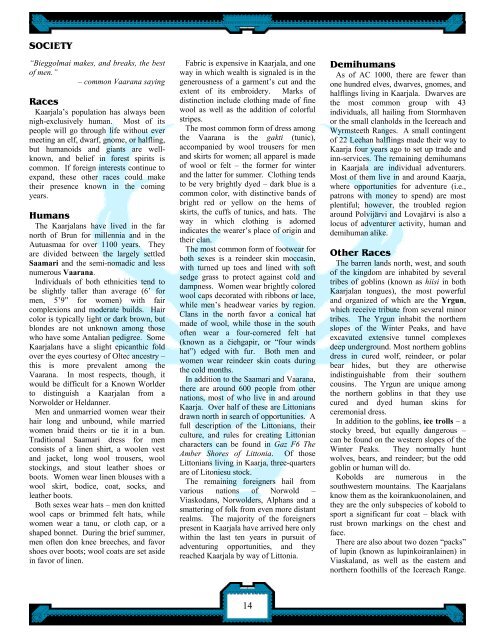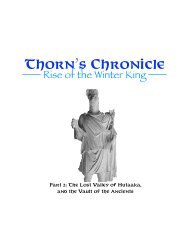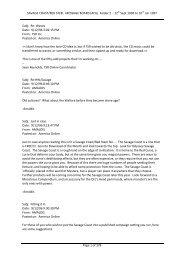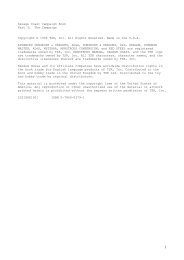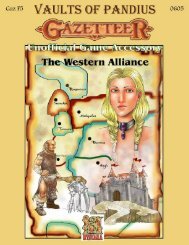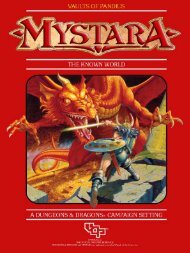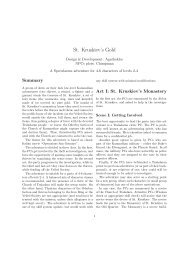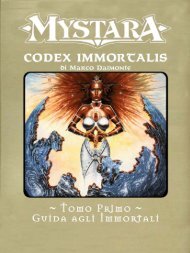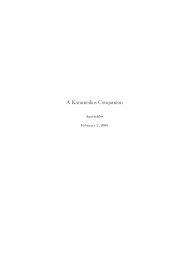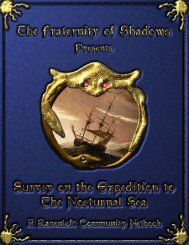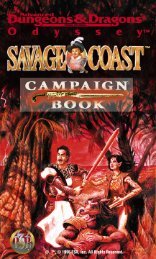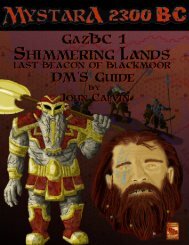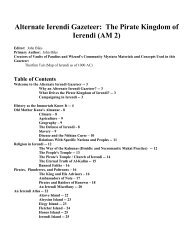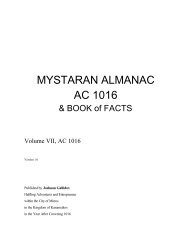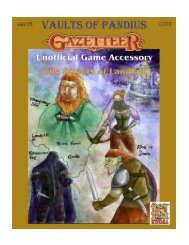Gaz F10 The Kingdom of Kaarjala - Vaults of Pandius
Gaz F10 The Kingdom of Kaarjala - Vaults of Pandius
Gaz F10 The Kingdom of Kaarjala - Vaults of Pandius
Create successful ePaper yourself
Turn your PDF publications into a flip-book with our unique Google optimized e-Paper software.
SOCIETY“Bieggolmai makes, and breaks, the best<strong>of</strong> men.”– common Vaarana sayingRaces<strong>Kaarjala</strong>’s population has always beennigh-exclusively human. Most <strong>of</strong> itspeople will go through life without evermeeting an elf, dwarf, gnome, or halfling,but humanoids and giants are wellknown,and belief in forest spirits iscommon. If foreign interests continue toexpand, these other races could maketheir presence known in the comingyears.Humans<strong>The</strong> <strong>Kaarjala</strong>ns have lived in the farnorth <strong>of</strong> Brun for millennia and in theAutuasmaa for over 1100 years. <strong>The</strong>yare divided between the largely settledSaamari and the semi-nomadic and lessnumerous Vaarana.Individuals <strong>of</strong> both ethnicities tend tobe slightly taller than average (6’ formen, 5’9” for women) with faircomplexions and moderate builds. Haircolor is typically light or dark brown, butblondes are not unknown among thosewho have some Antalian pedigree. Some<strong>Kaarjala</strong>ns have a slight epicanthic foldover the eyes courtesy <strong>of</strong> Oltec ancestry –this is more prevalent among theVaarana. In most respects, though, itwould be difficult for a Known Worlderto distinguish a <strong>Kaarjala</strong>n from aNorwolder or Heldanner.Men and unmarried women wear theirhair long and unbound, while marriedwomen braid theirs or tie it in a bun.Traditional Saamari dress for menconsists <strong>of</strong> a linen shirt, a woolen vestand jacket, long wool trousers, woolstockings, and stout leather shoes orboots. Women wear linen blouses with awool skirt, bodice, coat, socks, andleather boots.Both sexes wear hats – men don knittedwool caps or brimmed felt hats, whilewomen wear a tanu, or cloth cap, or ashaped bonnet. During the brief summer,men <strong>of</strong>ten don knee breeches, and favorshoes over boots; wool coats are set asidein favor <strong>of</strong> linen.Fabric is expensive in <strong>Kaarjala</strong>, and oneway in which wealth is signaled is in thegenerousness <strong>of</strong> a garment’s cut and theextent <strong>of</strong> its embroidery. Marks <strong>of</strong>distinction include clothing made <strong>of</strong> finewool as well as the addition <strong>of</strong> colorfulstripes.<strong>The</strong> most common form <strong>of</strong> dress amongthe Vaarana is the gakti (tunic),accompanied by wool trousers for menand skirts for women; all apparel is made<strong>of</strong> wool or felt – the former for winterand the latter for summer. Clothing tendsto be very brightly dyed – dark blue is acommon color, with distinctive bands <strong>of</strong>bright red or yellow on the hems <strong>of</strong>skirts, the cuffs <strong>of</strong> tunics, and hats. <strong>The</strong>way in which clothing is adornedindicates the wearer’s place <strong>of</strong> origin andtheir clan.<strong>The</strong> most common form <strong>of</strong> footwear forboth sexes is a reindeer skin moccasin,with turned up toes and lined with s<strong>of</strong>tsedge grass to protect against cold anddampness. Women wear brightly coloredwool caps decorated with ribbons or lace,while men’s headwear varies by region.Clans in the north favor a conical hatmade <strong>of</strong> wool, while those in the south<strong>of</strong>ten wear a four-cornered felt hat(known as a čiehgapir, or “four windshat”) edged with fur. Both men andwomen wear reindeer skin coats duringthe cold months.In addition to the Saamari and Vaarana,there are around 600 people from othernations, most <strong>of</strong> who live in and aroundKaarja. Over half <strong>of</strong> these are Littoniansdrawn north in search <strong>of</strong> opportunities. Afull description <strong>of</strong> the Littonians, theirculture, and rules for creating Littoniancharacters can be found in <strong>Gaz</strong> F6 <strong>The</strong>Amber Shores <strong>of</strong> Littonia. Of thoseLittonians living in Kaarja, three-quartersare <strong>of</strong> Litoniesu stock.<strong>The</strong> remaining foreigners hail fromvarious nations <strong>of</strong> Norwold –Viaskodans, Norwolders, Alphans and asmattering <strong>of</strong> folk from even more distantrealms. <strong>The</strong> majority <strong>of</strong> the foreignerspresent in <strong>Kaarjala</strong> have arrived here onlywithin the last ten years in pursuit <strong>of</strong>adventuring opportunities, and theyreached <strong>Kaarjala</strong> by way <strong>of</strong> Littonia.DemihumansAs <strong>of</strong> AC 1000, there are fewer thanone hundred elves, dwarves, gnomes, andhalflings living in <strong>Kaarjala</strong>. Dwarves arethe most common group with 43individuals, all hailing from Stormhavenor the small clanholds in the Icereach andWyrmsteeth Ranges. A small contingent<strong>of</strong> 22 Leehan halflings made their way toKaarja four years ago to set up trade andinn-services. <strong>The</strong> remaining demihumansin <strong>Kaarjala</strong> are individual adventurers.Most <strong>of</strong> them live in and around Kaarja,where opportunities for adventure (i.e.,patrons with money to spend) are mostplentiful; however, the troubled regionaround Polvijärvi and Lovajärvi is also alocus <strong>of</strong> adventurer activity, human anddemihuman alike.Other Races<strong>The</strong> barren lands north, west, and south<strong>of</strong> the kingdom are inhabited by severaltribes <strong>of</strong> goblins (known as hiisi in both<strong>Kaarjala</strong>n tongues), the most powerfuland organized <strong>of</strong> which are the Yrgun,which receive tribute from several minortribes. <strong>The</strong> Yrgun inhabit the northernslopes <strong>of</strong> the Winter Peaks, and haveexcavated extensive tunnel complexesdeep underground. Most northern goblinsdress in cured wolf, reindeer, or polarbear hides, but they are otherwiseindistinguishable from their southerncousins. <strong>The</strong> Yrgun are unique amongthe northern goblins in that they usecured and dyed human skins forceremonial dress.In addition to the goblins, ice trolls – astocky breed, but equally dangerous –can be found on the western slopes <strong>of</strong> theWinter Peaks. <strong>The</strong>y normally huntwolves, bears, and reindeer; but the oddgoblin or human will do.Kobolds are numerous in thesouthwestern mountains. <strong>The</strong> <strong>Kaarjala</strong>nsknow them as the koirankuonolainen, andthey are the only subspecies <strong>of</strong> kobold tosport a significant fur coat – black withrust brown markings on the chest andface.<strong>The</strong>re are also about two dozen “packs”<strong>of</strong> lupin (known as lupinkoiranlainen) inViaskaland, as well as the eastern andnorthern foothills <strong>of</strong> the Icereach Range.14


